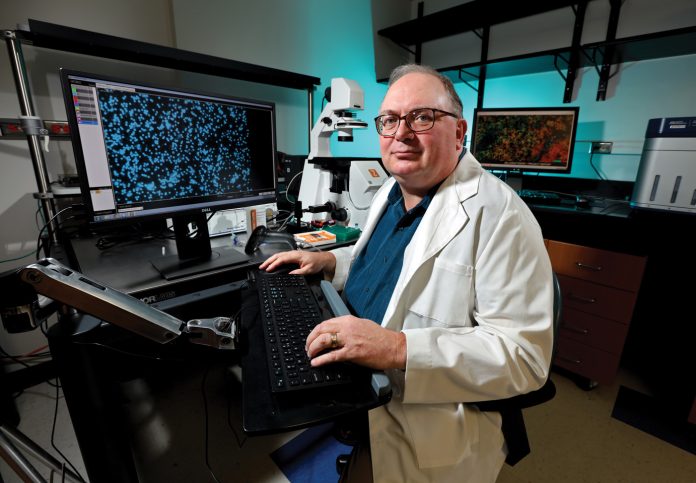The National Institutes of Health has awarded the Oklahoma Medical Research Foundation $5.8 million to work toward easier diagnosis and better treatment options for Sjögren’s disease, an autoimmune condition.
In Sjögren’s, immune cells attack moisture-producing glands, causing painful dry eyes and mouth. It can result in irreversible tissue damage, neurological problems, lung disease and cancer. There is no known cure, and current treatments address only the symptoms.
OMRF scientists Joel Guthridge, Ph.D., Darise Farris, Ph.D., and Christopher Lessard, Ph.D., received a four-year grant through the Accelerating Medicines Partnership in Autoimmune and Immune-Mediated Diseases Program (AMP AIM). The team’s goal is to develop less invasive clinical tools to diagnose patients more effectively and identify new targets for future treatments.
“This disease is notoriously difficult to diagnose,” said Lessard, who’s been studying Sjögren’s at OMRF since 2007. “It shares features with many autoimmune diseases and lacks effective diagnostic markers, which makes studying it challenging. This grant provides us with technology to analyze the salivary glands of people with Sjögren’s in a way that wasn’t possible previously.”
The researchers will use blood and biopsy tissue samples donated to OMRF by people with Sjögren’s to better understand different patient sub-groups’ genetic and molecular characteristics.
“This knowledge should help clinicians diagnose the disease more easily and determine who may benefit from different potential therapies,” Guthridge said.
Most studies of Sjögren’s have focused on patients who test positive for certain autoantibodies in the blood. However, a significant percentage of people with the disease test negative for those autoantibodies. In those cases, diagnosis requires an invasive biopsy of the salivary glands.
“Of the more than 600 people seen in our research clinic who met the criteria for Sjögren’s, about 40% tested negative for these autoantibodies,” said Farris, the Alvin Chang Chair of Biomedical Research at the OMRF. “This positions us to study the molecular issues unique to that particular Sjögren’s patient group.”
AMP AIM is a nationwide public-private partnership aimed at developing more effective treatments for autoimmune diseases. The partnership involves the NIH, Foundation for the National Institutes of Health, nonprofit disease foundations, biopharmaceutical and life-science companies, and 52 research institutions. OMRF Executive Vice President & Chief Medical Officer Judith James, M.D., Ph.D., is chair of the more than $60 million program.
The AMP AIM Sjögren’s research is funded by grant No. 3UC2 AR081032-02S1 from the National Institute of Arthritis and Musculoskeletal and Skin Diseases, part of the NIH. Farris and Guthridge received support from the Oklahoma City-based Presbyterian Health Foundation for experiments preceding the NIH grant. Additional support came to Farris from the Oklahoma Center for the Advancement of Science & Technology and to Guthridge from the Oklahoma Center for Adult Stem Cell Research.
For more information about ongoing Sjögren’s research at OMRF, visit www.omrf.org/sjogrens.













